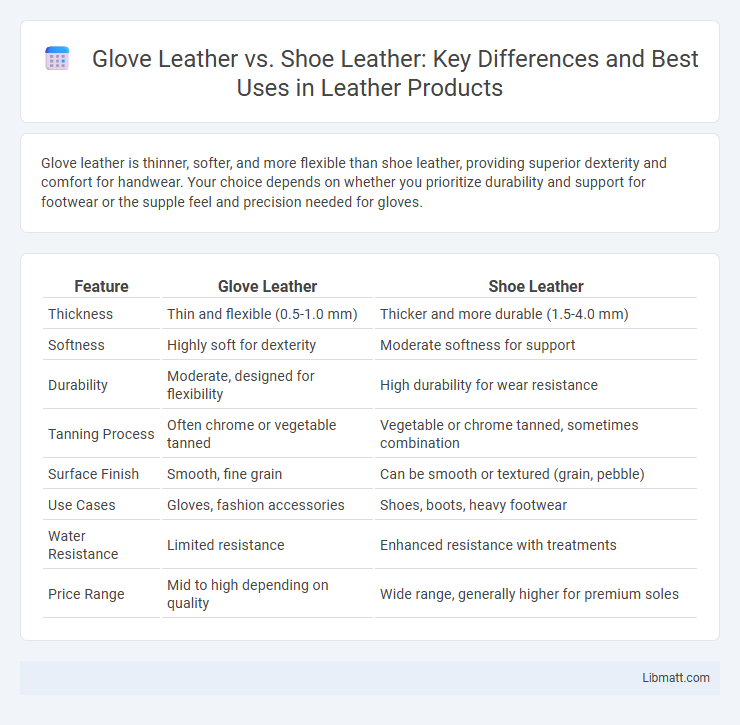Glove leather is thinner, softer, and more flexible than shoe leather, providing superior dexterity and comfort for handwear. Your choice depends on whether you prioritize durability and support for footwear or the supple feel and precision needed for gloves.
Table of Comparison
| Feature | Glove Leather | Shoe Leather |
|---|---|---|
| Thickness | Thin and flexible (0.5-1.0 mm) | Thicker and more durable (1.5-4.0 mm) |
| Softness | Highly soft for dexterity | Moderate softness for support |
| Durability | Moderate, designed for flexibility | High durability for wear resistance |
| Tanning Process | Often chrome or vegetable tanned | Vegetable or chrome tanned, sometimes combination |
| Surface Finish | Smooth, fine grain | Can be smooth or textured (grain, pebble) |
| Use Cases | Gloves, fashion accessories | Shoes, boots, heavy footwear |
| Water Resistance | Limited resistance | Enhanced resistance with treatments |
| Price Range | Mid to high depending on quality | Wide range, generally higher for premium soles |
Introduction to Glove Leather vs Shoe Leather
Glove leather is crafted from highly flexible, thin, and soft hides such as lamb or goat, designed to provide superior dexterity and comfort. Shoe leather typically uses thicker, more durable hides like cowhide or buffalo, offering enhanced abrasion resistance and support for footwear construction. Understanding the distinct properties and sourcing of glove leather versus shoe leather is essential for selecting the appropriate material based on intended use and performance requirements.
Key Differences in Leather Types
Glove leather is typically thinner, softer, and more flexible, designed for comfort and dexterity, while shoe leather is thicker, more durable, and structured to withstand wear and provide support. Glove leather often uses fine-grain hides from goats or deers, emphasizing suppleness and smooth finish, whereas shoe leather commonly derives from cowhide with a tougher grain to enhance abrasion resistance. The tanning process for glove leather often involves milder treatments to retain softness, contrasted with shoe leather that undergoes heavier tanning or coating to improve water resistance and longevity.
Raw Materials Used
Glove leather is typically crafted from thinner, softer hides such as lamb or goat, prioritizing flexibility and fine grain for a delicate, smooth finish. Shoe leather often uses thicker, more durable raw materials like cowhide or full-grain leather to withstand wear and provide structural support. Your choice depends on the desired balance between softness and durability, with glove leather favoring comfort and shoe leather emphasizing strength.
Tanning Processes Compared
Glove leather undergoes vegetable tanning or chrome tanning combined with a meticulous retanning process to achieve a soft, flexible, and supple texture suitable for handwear. Shoe leather typically involves heavier chrome tanning or a combination of chrome and vegetable tanning aimed at producing durable, firm, and abrasion-resistant characteristics ideal for footwear. The difference in tanning processes directly influences the grain tightness, flexibility, and finish quality between glove leather and shoe leather.
Texture and Flexibility
Glove leather is characterized by its exceptionally smooth texture and superior flexibility, designed to conform closely to the hand for a soft, supple feel. Shoe leather tends to be thicker and sturdier, providing durability and support with a coarser texture to withstand the rigors of daily wear. Your choice between glove leather and shoe leather will depend on the need for delicate flexibility versus robust structural integrity.
Durability and Wear-Resistance
Glove leather is typically thinner and more supple, offering excellent flexibility and comfort but less durability and wear-resistance compared to shoe leather. Shoe leather is thicker, denser, and treated for enhanced toughness, making it ideal for enduring constant abrasion and heavy use over time. When selecting materials for long-lasting footwear, your choice should lean towards shoe leather for superior durability and resistance to wear.
Comfort and Breathability
Glove leather offers superior comfort and breathability compared to shoe leather due to its thinner, softer, and more flexible texture, allowing for better air circulation and reduced moisture buildup. Shoe leather, often thicker and stiffer to provide durability and support, tends to trap heat and limit airflow, which can result in less comfort during extended wear. This makes glove leather ideal for applications where comfort and breathability are prioritized, while shoe leather is better suited for durability-intensive uses.
Common Applications of Each Leather
Glove leather is primarily used for making high-quality gloves, upholstery, and luxury accessories due to its softness, flexibility, and fine grain. Shoe leather, often heavier and more durable, is commonly utilized in crafting footwear, including dress shoes, boots, and casual shoes, providing strength and support for prolonged wear. Your choice between glove leather and shoe leather should consider the specific durability and comfort requirements of the intended application.
Maintenance and Care Tips
Glove leather requires gentle cleaning with a damp cloth and specialized leather conditioners to maintain its soft texture and prevent cracking, while shoe leather demands regular polishing and waterproofing to enhance durability and resist scuffing. Both types benefit from avoiding direct sunlight and excessive moisture, but glove leather's thinner composition necessitates more delicate handling. Proper storage, such as using shoe trees for shoe leather and padded containers for glove leather, helps preserve shape and longevity.
Choosing the Right Leather for Your Needs
Glove leather offers superior softness, flexibility, and thinness, making it ideal for delicate items requiring precision and comfort, such as gloves and fine accessories. Shoe leather is thicker, more durable, and resistant to wear, providing essential support and protection for footwear subjected to constant friction and pressure. Choosing the right leather for your needs depends on balancing flexibility with durability to ensure optimal performance and longevity.
Glove leather vs shoe leather Infographic

 libmatt.com
libmatt.com